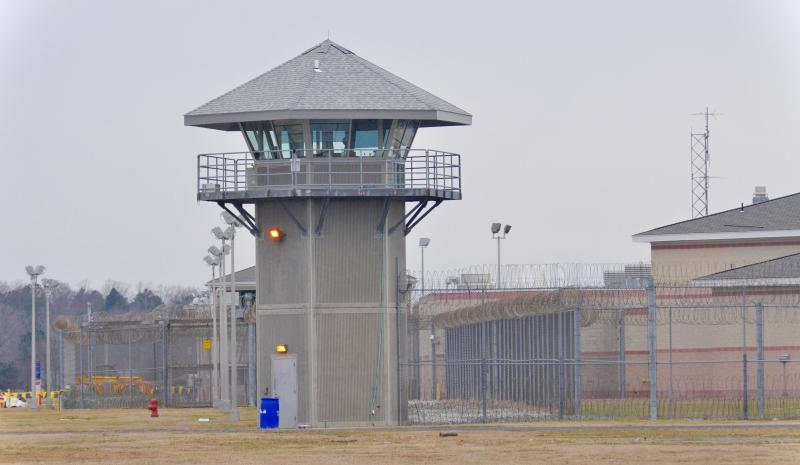Smyrna prison siege blamed on Minner, Markell
The family of a slain correctional officer and five of his fellow officers say in a lawsuit that two former Delaware governors deliberately reduced staffing in Delaware prisons, forcing overtime and security breaches that risked the lives of prison employees.
A federal lawsuit filed April 18 comes more than two months after a 19-hour siege at James T. Vaughn Correctional Center in Smyrna left Correctional Officer Lt. Steven Floyd dead and others seriously injured.
Attorneys with Wilmington-based Neuberger Firm and their plaintiffs - five Vaughn staff members held captive during the siege and Floyd's family - held a press conference at The Westin Wilmington to announce the lawsuit hours after it was filed in U.S. District Court for the District of Delaware.
“After an exhaustive, two-month investigation, today we charge that for 16 years, it has been the policy of two governors in Delaware deliberately not to employ enough officers to safely run Delaware's prisons,” said attorney Thomas Neuberger. “Instead, they spent up to $23 million a year forcing understaffed officers to work 16-hour shifts overtime to save money at the expense of putting their lives at risk at the hands of violent offenders.”
Neuberger said those policies were hidden from the General Assembly, and Minner and Markell repeatedly ignored recommendations to increase prison staffing. The lawsuit states that in the early 2000s, Minner ordered the elimination of any vacant positions at the Department of Correction.
“In doing so, the Minner defendants sought to distort the actual numbers so they did not appear as bad for public and legislative consumption,” the suit states.
Eliminating positions led to deteriorated conditions in Delaware prisons by reducing staff, which made proper security checks impossible, the lawsuit states.
“The more understaffed a facility is, the higher the risk of harm to the correctional officers, the inmates and, ultimately, the public,” the suit states.
In 2004, a female prison counselor was raped at Vaughn by an inmate serving 660 years for rape, prompting Minner to create a task force to prevent future violent events. The task force recommended hiring more officers and ending reliance on overtime. It also found inadequate training and supervision, and failure to adequately search inmates for weapons all contributed to a dangerous environment.
“But did Minner follow this disinterested advice? No,” Neuberger said. “She just passed it on to her successor, Gov. Markell, and guess what he did? Under his reign, there still were not enough officers to search for weapons, overtime rose from about $8 million to $23 million - 800,000 overtime hours worked in his last year in office, the equivalent of 470 employees - and he issued an order that at least 90 positions had to be kept vacant permanently.”
Neuberger and attorney Thomas Crumplar argue Minner and Markell “were derelict in their duties to protect those working within our system.”
Neuberger described Vaughn's Building C as a death trap. He told reporters there were no cameras to help deter crime within the prison or document the events that unfolded when correctional officers were taken hostage, and Floyd, an Army veteran and Sussex Central High School graduate who worked for the Department of Correction for 16 years, was killed. The lawsuit states cameras also could have helped rescuers during the siege.
“In 2005, the issue of cameras was raised and brought to Minner's attention,” he said. “But was something done? No.”
The 52-page lawsuit also argues in the months leading to the uprising, the Markell administration and former Department of Correction Commissioner Robert Coupe were repeatedly alerted that conditions were going to explode, specifically in Vaughn's Building C.
“But all those warnings to Commissioner Coupe, now our homeland security director, were apparently ignored,” Neuberger said.
As a result of forced overtime, staff cuts and a lack of training, the state created dangerous work conditions in violation of officers' 14th amendment rights, the suit argues. The defendants' actions shock the conscience, the suit states, as state officials ignored recommendations and problems for more than a decade.
The lawsuit also names former DOC Commissioner Stanley W. Taylor Jr., former DOC Commissioner Carl C. Danburg, former Office of Management and Budget Director Ann Visalli, former OMB acting Director Brian Maxwell, DOC Commissioner Perry Phelps, OMB Director Michael S. Jackson and the Department of Correction as defendants in the case. The suit seeks compensatory and punitive damages and calls for Floyd's autopsy report to be released to his family.
Neuberger estimates that as a result of legal delays, it could take years before the case goes to trial.
Problems persist
Less than a week after the February siege, the Department of Correction announced another assault at Vaughn, and an additional assault was reported April 15. Dover attorney Steve Hampton said some prison employees called out of work April 17, protesting their ongoing poor work conditions.
Hampton argues correctional officers aren't the only ones at risk in Delaware's prisons. Hampton said he has been contacted by more than 170 inmates and their families seeking some type of action against Department of Correction employees because of the treatment they've received since the February riot.
“There are many inmates who have been brutalized or tortured,” he said in a phone interview April 18.
When police breached Building C Feb. 2, “they beat pretty much everybody that was there,” Hampton said. “They threatened them, used racial or sexual language toward them and beat them. Even as they had their hands zip-tied and their feet tied or shackled, they continued to beat them.”
He said inmates experienced two or three beatings on that day. Some were seen by medical professionals, but others waited more than a month before receiving medical care. Since then, inmates have been abused on numerous occasions, he said. Some say they have been sexually assaulted and denied the ability to report those crimes, he said.
“And it hasn't gotten a lot better from there,” he said. Hampton said he intends to file a class-action lawsuit as a result of prisoner abuse.
Hampton said he said the argument used in the Neuberger Firm's April 18 federal lawsuit - that problems in Delaware prisons have been long ignored - is accurate.
“The problems that have led to this were well known to Markell and Minner,” he said. “They just chose not to do anything about it.”
Suit says Carney delayed rescue at prison
A lawsuit filed by the family of slain Lt. Steven Floyd and five surviving officers of the February siege at James T. Vaughn Correctional Center says Gov. John Carney overruled the prison warden, delaying rescue of the captured prison workers. The following account is based on details provided in the suit.
Feb. 1
Morning: Correctional Officers Lt. Steven Floyd, then a sergeant, Winslow H. Smith and Joshua Wilkinson were working in different areas of Building C, while officers Cpl. Owen Hammond, Cpl. Matthew McCall and Cpl. Justin Tuxward were working on the boilers in the basement of Building C.
About 10:20 a.m.: A large group of inmates staged a fight on Tier B of the building; when Floyd tried to break up the fight, he was attacked and beaten. Groups of 5 to 15 inmates, wearing contraband masks and armed with contraband weapons, also attacked and beat Smith and Wilkinson. As Smith was being beaten, he saw inmates assaulting counselor Patricia May and tried to help her, but he was beaten down and dragged out of her office.
The inmates handcuffed Wilkinson and Smith and threw both into a small maintenance closet. Floyd was beaten and thrown into a nearby closet.
Inmates then started fires, activating the sprinkler systems. Floyd warned responders with the Quick Response Team it was a trap. They heeded his warning and exited the building. The inmates, enraged by Floyd's warning, then “brutally tortured [him] for a long period of time,” the suit states. Smith and Wilkinson could hear what was happening, but they were trapped in the closet and could not help.
About 11:30 a.m.: The warden gave the go-ahead for the prison's Community Emergency Response Team to retake the building, but Gov. John Carney overruled the warden and halted the rescue attempt, the suit states.
About 2:25 p.m.: Inmates removed Smith from the closet and told him to memorize five names to take to authorities. He was released and rescued.
About 8 p.m.: An inmate got into the closet with Wilkinson, held a large blade to his throat and told him to radio to hostage negotiators that an inmate was threatening to kill him. He complied, and inmates later removed him from the closet, covered his head with a pillowcase and walked him into the yard where he was rescued.
Sometime in the evening: It is believed the inmates murdered Floyd well into the siege. “Plaintiffs are as of yet unable to determine when Sgt. Floyd's death occurred due to the governor's refusal to release the autopsy results privately to his family,” the lawsuit states.
Meanwhile: Hammond, McCall and Tuxward heard a commotion as they finished working on the boilers. When they finished, they walked upstairs and met an inmate who told them “they have taken the building,” among other things. After seeing a large streak of blood on the floor, the three officers thought a fight had occurred between inmates. They then heard Floyd calling for help from a closet, but did not have the key to unlock the door. They were confronted by an armed inmate, who they threatened with the chemical they were carrying in a container after using it on the boilers. They quickly retreated back to the basement, where they called in a “Code One” and “Code Three,” meaning there was an attack on an officer and a major disturbance at the prison. They reported what they could while barricaded and locked inside the basement. At numerous times they turned off the gas, heat, hot water and water supply to the building and reset phones as instructed.
After spending about 12 hours imprisoned in the basement, rescuers told them to slowly and quietly access the attic and climb a cupola-like structure to reach the roof. From there, the three officers were rescued.
Feb. 2
Around 5 a.m.: Gov. Carney permitted SWAT teams from the Delaware State Police and the Maryland State Police to storm the building and end the uprising.






















































